Hi and welcome to this year’s worldwide report based on the 11,242 responses to the Gender Census, which ran from 25th February until 30th March. It was mostly shared on Tumblr and Twitter, with some Reddit and Facebook and no doubt some one-to-one link-sharing too.
You can see the spreadsheet of results in full here, which might be helpful if you need to see graphs or figures in more detail. For the charts and graphs of statistics over time, the summary spreadsheet can be found here.
Q1. Identity words
As in previous years, I asked: Which of the following best describe(s) in English how you think of yourself?
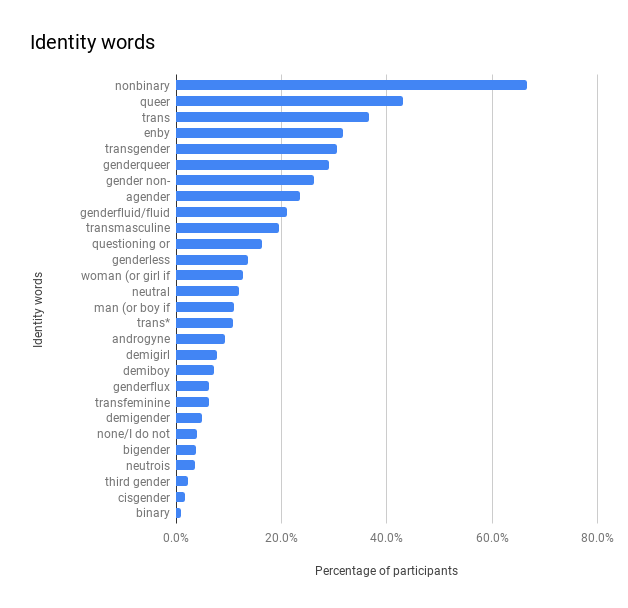
Here’s the top 5:
- nonbinary – 66.6% (up 6%)
- queer – 43.0% (up 40.1%)
- trans – 36.6% (up 1.8%)
- enby – 31.7% (up 7.2%)
- transgender – 30.4% (up 2.5%)
I put queer in bold because it’s new to the list, and the way it’s rocketed to second place is very unusual… and a little suspicious.
The wording of the identity question carefully avoids mentioning gender so that people without genders feel comfortable answering (or not answering), but it’s not really meant to include sexualities. The exception is sexualities that are part of someone’s gender identity, like this comment that someone wrote into the identity checkbox: “femme lesbian (sometimes i feel like lesbian *is* my gender)”
So anyway, last year queer got 2.9% (over the 1% threshold), and I personally know people who feel that their gender is queer, so I added it to the list. Usually when terms are added as checkbox options it might multiply their popularity by about four, but 43% is way too high to be explained by that. Queer is usually used to describe sexuality, so I think perhaps people who identify as queer in terms of their sexuality might have been selecting it too. I’m considering changing it slightly, to something like “queer (as gender identity)” to clarify it for next year. It’s possible that we won’t know if this percentage is due to bad survey design for a year or two.
(Edit: Some feedback on queer and my response to the feedback can be found here.)
Along those lines, several terms were added to the checkbox options this year because they were typed in by over 1% of participants last year:
- queer
- genderless
- demiboy
- demigirl
- gender non-conforming
There are now 28 terms in the identity checkbox list, and as usual there were people expressing gratitude for the abundance of checkbox options in the identity question. However, there has also been an increase in people entering words into the textboxes that are already in the checkbox list. That means that people are missing or are not able to find the identity words they connect with more than last year, and it doesn’t help that the list is randomised to reduce primacy and recency bias.
Right now I add words to the checkbox list if they reach 1%, and this year for the first time I am considering adding another system for removing words that are not used as much. You can read a blog post I wrote about that here. I concluded based on the results of the 2017 survey (which asked for participants’ ages) that some words that seem to be used less overall are used more often by participants over 30, and since participants over 30 are underrepresented in online surveys generally I will be keeping any word that they enter over 3% of the time even if the word isn’t used as much overall.
Relatedly, I didn’t ask for ages in the survey this year, but I will be collecting information about age in future surveys to make sure that I don’t remove words and accidentally alienate underrepresented age groups. (The age question will be optional and will give age ranges rather than asking for an exact age, so hopefully that won’t make people feel too uncomfortable.)
This year someone complained for the first time that I was excluding words from other languages because I specify “in English” in the question, and if you know me from previous surveys you know that’s the opposite of my intention! Every word entered is counted, and I’m very aware that people use words from other languages while speaking English. So I’m considering rewording the question, but I welcome feedback on this since I’ve never had anyone complain about this issue before and plenty of people already enter non-English words.
And here’s this year’s top 10 words and their popularity over time:
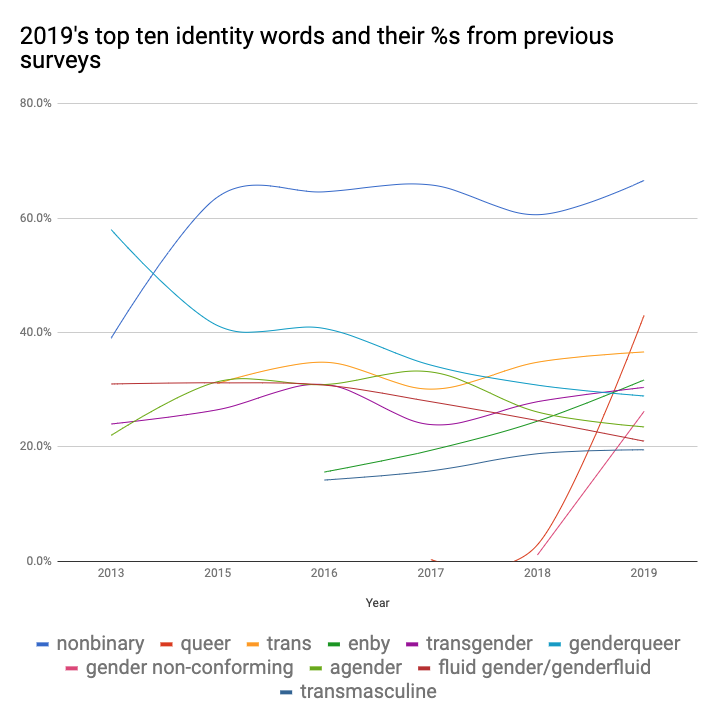
Those two lines shooting up from 2018 to 2019 are two of the words newly added this year: queer and gender non-conforming. That green line starting near the bottom in 2016 and steadily increasing over time is more like what I’d usually expect – that’s enby, which is now up to #4 on the list.
There are no new identity words to add next year; the closest to 1% was butch with 0.7%. However, since I intend to collect information about age and since people often type, for example, “girl but not woman, even though I am not a minor”, I will be splitting girl, woman, man and boy into separate checkboxes next year.
2,021 unique identity words/terms were typed into the “other” textbox, including 413 that were entered more than once. The average number of type-ins for people who actually typed words in was 1.8, and the average words per person overall was 5. Most entered 4 words:
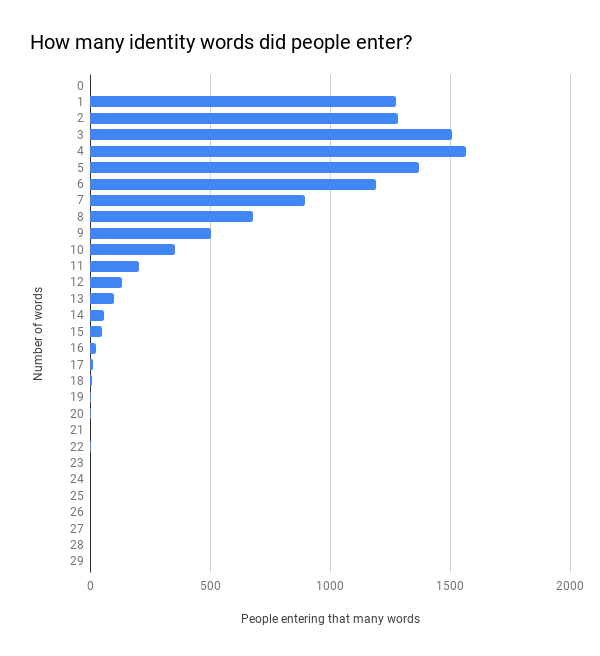
Q2: Titles
I asked, Supposing all title fields on forms were optional and write-your-own, what would you want yours to be in English? I also clarified that participants should be currently entitled to use it, so they should have a doctorate if they choose Dr, etc.
There were 5 specific titles to choose from, plus a few options like “I choose on the day” and “a non-gendered professional or academic title”. Participants could choose only one, with the goal of finding out what, when pressed, people enter on official records forms and ID.
Here’s our top 5:
- No title at all – 33.0% (up 0.6%)
- Mx – 31.3% (down 1.3%)
- Mr – 8.7% (up 0.2%)
- Non-gendered prof/acad. – 5.5% (up 0.1%)
- Ms – 4.7% (down 1.0%)

Here’s how that looks compared with previous years:

Mx and no title switched places again for the fifth year in a row! And this year I made a similar graph but without Mx and no title. They always get way more than everything else, and it makes it really hard to see what’s going on in the lower half of the graph!

That rollercoaster of a red line is because in 2018 I specified that “non-gendered professional/academic title” should be one that the participant should be entitled to use, which caused that significant drop.
The most popular five “other” textbox titles were:
- M – 28 (0.2%)
- Comrade – 17
- Sir – 10
- Mrs – 9
- Ser – 7
As with last year, I invited people who chose “a standard title that is used only by people other than men and women” (2.5% of participants) to optionally suggest titles that they’d heard of. The goal is to find a popular title that is considered exclusive to nonbinary genders the way Mr is generally considered exclusive to men and Ms is to women.
243 people checked the “standard exclusive nonbinary” title option, and here’s everything entered more than once:
- Mx – 16
- M – 4
- Xr – 2
- Mrs – 2
Mx is generally considered gender-inclusive by people who are familiar with it, especially if their title is Mx, but it’s high on this list because Mx is very well-known generally. M in French is masculine, but in English it’s not gendered and I assume it’s pronounced “em”? (That seems to be what people have said in the notes, but please do tell me if I’m wrong!) It was also the most entered title in the “other” textbox. Xr is new to me, I’m not sure how it’s pronounced.
Q3: Pronouns
The fourth question was actually a complex set of questions retained from last year, which started with Supposing all pronouns were accepted by everyone without question and were easy to learn, which pronouns are you happy for people to use for you in English? This was accompanied by a list of pre-written checkbox options. It included “a pronoun set not listed here”. and if you chose that it took you to a separate set of questions that let you enter up to five pronoun sets in detail.
As usual, everything that was a pre-written checkbox option got over 1%.
Here’s the top 5:
- Singular they – they/them/their/theirs/themself – 79.5% (up 2.1%)
- He – he/him/his/his/himself – 30.8% (down 0.4%)
- She – she/her/her/hers/herself – 29.0% (down 1.9%)
- None/avoid pronouns – 10.3% (up 0.2%)
- Xe – xe/xem/xyr/xyrs/xemself – 7.2% (down 0.2%)
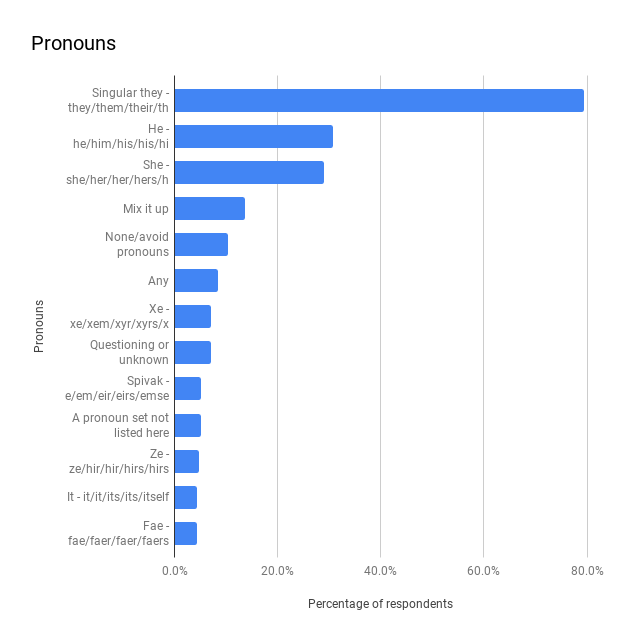
Here’s how that looks over time:

Because singular they, he and she always do better than everything else, let’s look at that chart without them. Every other specific pronoun set got under 8%.

Here’s the top 5 textbox neopronouns, none of which got over 1%:
- ne/nem/nemself (singular verbs) – 27 (0.2%)
- ve/ver/verself (singular verbs) – 24
- ey/em/emself (singular verbs) – 23
- ae/aer/aerself (singular verbs) – 22
- thon/thon/thonself (singular verbs) – 18
(I’m going by the subject, object and reflexive, because that seems like the best way to collect similar sets together – eyeballing it, the most variations occur in the possessives.)
Half of participants don’t like he or she, and 9% like neither he, she nor they. 695 unique sets of neopronouns were entered by 574 people, of which 84 were entered more than once. The average number of pronouns entered was 2.2, and most people (39%) were happy with one set.
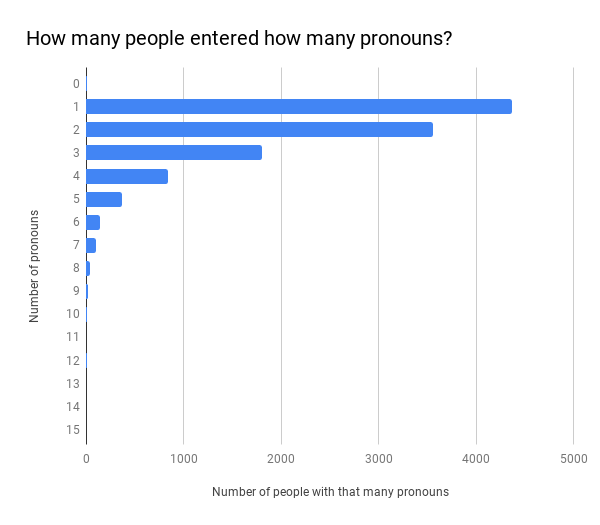
Overall it looks like there are no neopronouns really gaining in popularity, and even the checkbox neopronouns are being used less since 2015.
The questions I ask
- What should the third gender option on forms be called? – Still no consensus, but nonbinary is at 2 in 3 people and it does seem to be gradually climbing.
- Is there a standard neutral title yet? – Not yet. Mx is still consistently far more popular than all other titles, but just as many nonbinary people want no title at all. It’s really important that activists campaigning for greater acceptance of gender diversity remember to fight for titles to be optional, too.
- Is there a pronoun that every nonbinary person is happy with? – No. The closest we have to a standard is singular they, and it’s important for journalists and anyone else with a style guide to allow it. It’s levelled out at about 1 in 5 not being into singular they, and 9% of us don’t like he, she or they pronouns.
- Are any of the neopronouns gaining ground in a way that competes with singular they? – No. This year the closest is “Xe – xe/xem/xyr/xyrs/xemself” (7.2%, compared to singular they’s 79.5%). Users of these neopronouns will probably not reach consensus for many years – language and especially pronouns can be very slow to settle and gain ground. Even if one neopronoun does become very commonly used, many will continue to use other neopronouns for a long time to come.
This year in review
Crowdfunding was successful enough that I have a little money leftover for costs next year. We had around the same number of participants as last year, but follower numbers and mailing list subscribers increased, which bodes well for next year.
I made some minor changes to the promotional illustrations to make them more gender-/sex-inclusive, and this year I got no complaints, so that was a good move! However, this year I did see a lot more confusion about who is invited to take part. I think the changes were probably worth it to make sure I’m being as welcoming and inclusive as I can be in the promotional stuff, so hopefully people will err on the side of caution and just jump in.
The way that the new survey software collects information, and my increased knowledge of Google Sheets, mean that I didn’t have to resort to MS Excel at all this year. This is really good, because working with unfamiliar software slows me down a lot! My formulae have been more efficient (thanks to my increasing Google Sheets skillz), so the entire sheet could be processed at once instead of being split into several questions. I’m really happy about that, because it means the entire worldwide results report came out less than 24 hours after the survey closed, instead of… *cough* eight months *cough* …
I made an executive decision not to do a UK report this year, because the added complication makes it really hard for me to motivate myself. It definitely worked, look at that, it’s only March and the worldwide report is already out! I might still do a UK report, and I will keep collecting UK/not UK info about participants so that I always have that option, but for now I’ll just concentrate on the worldwide report and just do the UK report if I feel like it before 2020. And of course the spreadsheet is available to anyone who wants to download it and play with it, so if someone else wants to make some UK-specific statistics happen that is totally possible.
What I’ll do differently next year
- In the identity question, I will keep queer as a checkbox option, but I will specify that it’s a gender. Maybe “queer (as gender identity)”? Feedback welcome on this!
- In the pronouns question, I’ll change the wording of “none/avoid pronouns” so that it’s clear that it includes just using someone’s name. That’s because a lot of people tried to enter their names as neopronoun sets to express that, and I want to avoid people entering identifying information.
- I will ask about age, to make sure that people over 30 are represented by checkbox options. Typically only about 10% of participants are over 30 so I want to make sure as many as possible are comfortable taking part. I’ll group ages into sets of 5 years (21-25, 26-30, etc.) to reduce risk of people being identified, and because entering an exact age probably feels a little more uncomfortable.
- After 2020, any identity word, title or pronoun that is entered by less than 3% of participants and less than 3% of participants over 30 can be removed in future surveys. (I am a little concerned about this part, because it’ll make the work more complicated for me, and more work means more risk of epic procrastination. I’ll do my best!)
- I’ve finally admitted to myself that I need to separate man and boy, and woman and girl. Currently it’s “woman (or girl if younger)” and “man (or boy if younger)”, and every year plenty of people skip those options in the checkboxes and type in “girl (but not woman even though I’m not a minor)” or something like that, and next year I’ll be asking about age so that’ll be an easy way to determine if there are any adults who are comfortable with one and not the other. This will increase the number of checkboxes to 30, which is pretty unwieldy and will make it harder yet again for people to find their words and increase the rate at which people drop out of the survey, so I’m glad for the under-3% checkbox removal threshold that I’m introducing from 2021 onwards.
Closing thoughts
I slipped up on a couple of things this year (ambiguity over the word “queer”, for example) – but overall I’m pretty impressed with how well I handled it all compared to last year. (I had recently moved house and was trying to rebuild my life, so I didn’t have a lot of spare energy in 2018!)
As always, I’m excited to pore through all your written answers and feedback, and I’m really grateful to everyone who shared the survey link! There were hundreds of RTs and thousands of reblogs, which never ceases to amaze me. Thank you everyone for sharing a small linguistic part of yourselves with me, I hope putting it all together helps you and makes a positive difference to the world!
Support me!
I do this basically for free (the crowdfunded money goes entirely on survey software and domain fees), so if you happened to stumble onto my Amazon wishlist and accidentally fall on an Add To Cart button… well, I would be immensely grateful. 😉 If you wanted to go and check out Starfriends.org too I reckon Andréa would be pretty chuffed!
2019-03-31
email: hello@gendercensus.com